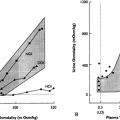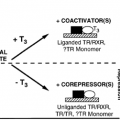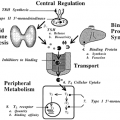MANAGEMENT OF MACROPROLACTINOMAS
Part of “CHAPTER 13 – PROLACTIN AND ITS DISORDERS“
Unlike patients with microprolactinomas, those with macropro-lactinomas always require therapy. Patients with macroade-nomas
may have evidence of local mass effects due to the tumor mass, with resultant visual field abnormalities, and hypopitu-itarism due to compression of the normal pituitary gland. Aggressive management is required to prevent or reverse these complications. Bromocriptine therapy results in significant tumor shrinkage in as many as 75% of patients. Tumor size reduction may occur in weeks or over many months, and this reduction is frequently accompanied by an improvement in visual field abnormalities and pituitary function. Visual field deficits have been reported to improve within hours of institution of medical therapy. Of 27 patients treated with bromocriptine, 64% experienced a reduction in tumor size of at least 50%.74 Tumor shrinkage often occurred within 6 weeks. Sixty-six percent of patients had normalization of prolactin levels, but the fall in prolactin levels did not always correlate with reductions in tumor size.
may have evidence of local mass effects due to the tumor mass, with resultant visual field abnormalities, and hypopitu-itarism due to compression of the normal pituitary gland. Aggressive management is required to prevent or reverse these complications. Bromocriptine therapy results in significant tumor shrinkage in as many as 75% of patients. Tumor size reduction may occur in weeks or over many months, and this reduction is frequently accompanied by an improvement in visual field abnormalities and pituitary function. Visual field deficits have been reported to improve within hours of institution of medical therapy. Of 27 patients treated with bromocriptine, 64% experienced a reduction in tumor size of at least 50%.74 Tumor shrinkage often occurred within 6 weeks. Sixty-six percent of patients had normalization of prolactin levels, but the fall in prolactin levels did not always correlate with reductions in tumor size.
Administration of cabergoline may lead to reduction in pro-lactin levels, tumor shrinkage, and restoration of gonadal function in patients with macroprolactinomas. When cabergoline was administered to 14 patients with macroprolactinomas, tumor shrinkage was observed in 13 (93%), and complete disappearance was documented in 2 patients.75 In one such study, cabergoline was administered to 15 patients with macroprolacti-nomas in a multicenter, 48-week trial (see Fig. 13-3).76 Normalization of prolactin levels was achieved in 73% of subjects, and mean reduction in tumor size was 31%. In this study, tumor shrinkage often occurred during the first 8 weeks; however, in some subjects, reductions in tumor volume were not seen until 24 weeks. Therefore, cabergoline may have an important role in the management of patients with macroprolactinomas.77 Dosages of 0.5 to 3.0 mg cabergoline per week are often sufficient for maximal effects. The drug may be useful as first line therapy in patients with macroprolactinomas or in those who are intolerant of or resistant to bromocriptine.52
Stay updated, free articles. Join our Telegram channel

Full access? Get Clinical Tree







